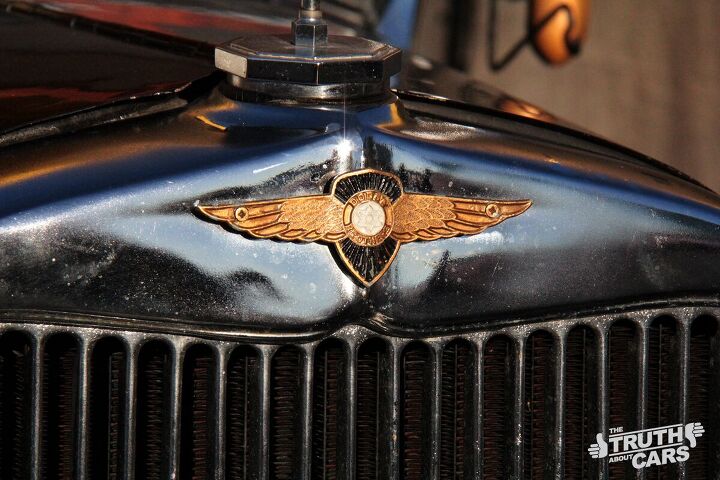Reporting From The Concoures D'eregance In Tokyo: The Americans In Japan

Today, I was in Odaiba, the man-made island in Tokyo Bay. The island is known for its futuristic buildings. Today, it was home of the Japan Classic Car Association’s New Year Meeting. It celebrates the imported car. During the next days, I will show you the nicer ones. We start with the Americans, and a Dodge.
The tonier places in America, like Pebble Beach and Hilton Head, are known for their Concours d’Elegance, something the organizers wanted to bring to Tokyo. It looks like it was damaged in transit.
Some of the first cars in Japan were American, just like this early Dodge Brothers model. The first car made in Japan, in 1902, was powered by a gasoline engine, hand-imported from the U.S. by Komanosuke Uchiyama. Five years later, he produced the first entirely Japanese-made car.
Detroit pretty much owned the Japanese car market before the war. Ford, Chrysler, and General Motors all had production plants in the island nation. Between 1925 and 1936, the Big Three produced 208,967 cars in Japan. Japanese automakers, and there were many, made only 12,127.
Cars imported to Japan, mostly from America and England, did set the style for Japanese cars.
After the war, American makers liked to use their British subsidiaries to export cars to Japan. This is the egg crate grille of a Nash Metropolitan Roadster, built between 1953 and 1961 at Austin’s Longbridge plant.
Except that this Nash has the steering wheel on the left. Must have been the export model.
This is a Ford Prefect, built in the UK.
It looks like the 100E (1953 to 1959). Its steering wheel is at the right left, I mean, it was left at the right side. Next to the Prefect sits a BMW 2002, the predecessor of the 3-series. I had one of those, also in Bavarian Blue.
Wedged between a Porsche and a Triumph, a Shelby GT350. When this car came to Japan, the glory of American imports in Japan began to fade, and the Europeans took over. We will look at them tomorrow.

Bertel Schmitt comes back to journalism after taking a 35 year break in advertising and marketing. He ran and owned advertising agencies in Duesseldorf, Germany, and New York City. Volkswagen A.G. was Bertel's most important corporate account. Schmitt's advertising and marketing career touched many corners of the industry with a special focus on automotive products and services. Since 2004, he lives in Japan and China with his wife <a href="http://www.tomokoandbertel.com"> Tomoko </a>. Bertel Schmitt is a founding board member of the <a href="http://www.offshoresuperseries.com"> Offshore Super Series </a>, an American offshore powerboat racing organization. He is co-owner of the racing team Typhoon.
More by Bertel Schmitt
Latest Car Reviews
Read moreLatest Product Reviews
Read moreRecent Comments
- Kjhkjlhkjhkljh kljhjkhjklhkjh *Why would anyone buy this* when the 2025 RamCharger is right around the corner, *faster* with vastly *better mpg* and stupid amounts of torque using a proven engine layout and motivation drive in use since 1920.
- Kjhkjlhkjhkljh kljhjkhjklhkjh I hate this soooooooo much. but the 2025 RAMCHARGER is the CORRECT bridge for people to go electric. I hate dodge (thanks for making me buy 2 replacement 46RH's) .. but the ramcharger's electric drive layout is *vastly* superior to a full electric car in dense populous areas where charging is difficult and where moron luddite science hating trumpers sabotage charges or block them.If Toyota had a tundra in the same config i'd plop 75k cash down today and burn my pos chevy in the dealer parking lot
- Kjhkjlhkjhkljh kljhjkhjklhkjh I own my house 100% paid for at age 52. the answer is still NO.-28k (realistically) would take 8 years to offset my gas truck even with its constant repair bills (thanks chevy)-Still takes too long to charge UNTIL solidsate batteries are a thing and 80% in 15 minutes becomes a reality (for ME anyways, i get others are willing to wait)For the rest of the market, especially people in dense cityscape, apartments dens rentals it just isnt feasible yet IMO.
- ToolGuy I do like the fuel economy of a 6-cylinder engine. 😉
- Carson D I'd go with the RAV4. It will last forever, and someone will pay you for it if you ever lose your survival instincts.












































Comments
Join the conversation
I've always wondered why JDM cars are RHD. Given the historical precedence of American cars in the early JDM, I would have thought they would drive on the right like we do. Do any of the B&B know why?
And yet, there are a few LHD cars in Japan - some folks like them because they're different - a fair amount of BMWs and Mercs in Japan are LHD. Never mind that they have to use a long pole with a basket to pay highway and bridge tolls.